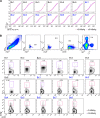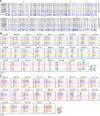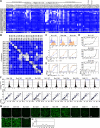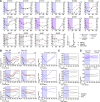Potent human broadly neutralizing antibodies to hepatitis B virus from natural controllers
- PMID: 32579155
- PMCID: PMC7537403
- DOI: 10.1084/jem.20200840
Potent human broadly neutralizing antibodies to hepatitis B virus from natural controllers
Abstract
Rare individuals can naturally clear chronic hepatitis B virus (HBV) infection and acquire protection from reinfection as conferred by vaccination. To examine the protective humoral response against HBV, we cloned and characterized human antibodies specific to the viral surface glycoproteins (HBsAg) from memory B cells of HBV vaccinees and controllers. We found that human HBV antibodies are encoded by a diverse set of immunoglobulin genes and recognize various conformational HBsAg epitopes. Strikingly, HBsAg-specific memory B cells from natural controllers mainly produced neutralizing antibodies able to cross-react with several viral genotypes. Furthermore, monotherapy with the potent broadly neutralizing antibody Bc1.187 suppressed viremia in vivo in HBV mouse models and led to post-therapy control of the infection in a fraction of animals. Thus, human neutralizing HBsAg antibodies appear to play a key role in the spontaneous control of HBV and represent promising immunotherapeutic tools for achieving HBV functional cure in chronically infected humans.
© 2020 Hehle et al.
Conflict of interest statement
Disclosures: V. Hehle reported a patent to anti-HBV antibodies and methods of use, pending. M. Beretta reported a patent to anti-HBV antibodies and methods of use, pending. M. Bourgine reported a patent to anti-HBV antibodies and methods of use, pending. M. Ait-Goughoulte reported a patent planned on the antibodies pending, "Roche." S. Pol reported personal fees from Gilead, Abbvie, BMS, Janssen, and Roche outside the submitted work. H. Strick-Marchand reported a patent to human neutralizing HBV antibodies and their use thereof, pending. N. Pelletier reported personal fees from Hoffmann-La Roche outside the submitted work; in addition, N. Pelletier had a patent planned to be submitted, pending "Roche Innovation Center Basel." H. Mouquet reported grants from Institut Roche during the conduct of the study; in addition, H. Mouquet had a patent to anti-HBV antibodies and methods of use, pending. No other disclosures were reported.
Figures












Comment in
-
Neutralizing hepatitis B.J Exp Med. 2020 Oct 5;217(10):e20201261. doi: 10.1084/jem.20201261. J Exp Med. 2020. PMID: 32790869 Free PMC article.
References
Publication types
MeSH terms
Substances
LinkOut - more resources
Full Text Sources
Other Literature Sources

